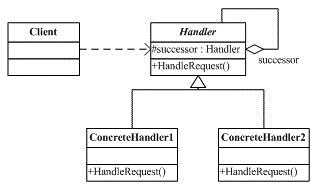标签:smo 依赖 int 责任链模式 false image new 敏捷开发 ati
设计模式是面向对象编程的基础,是用于指导程序设计。在实际项目开发过程中,并不是一味将设计模式进行套用,也不是功能设计时大量引入设计模式。应该根据具体需求和要求应用适合的设计模式。设计模式是一个老话题了,因为最近在设计“网关API”组件(后续介绍),采用“责任链设计模式”进行设计,所以先进行回顾记录。
一、责任链模式介绍
责任链模式是指一个处理需要涉及多个过程或者角色参与处理,并基于某个约定组成一个链,每个过程或者角色拥有各自职责进行处理。责任链模式有效组织一个过程处理,同时子过程之间职责明确。在.NET平台中很常见此模式应用。例如管道方式就可以采用责任链模式进行设计实现。
二、责任链模式结构图
如下图所示,此类图就是责任链模式核心的结构图,常见定义一个接口各子过程基础此接口实现,通过接口进行解耦子过程之间依赖。

三、责任链模式实现
通过如下简单DEMO进行展示责任链的实现。定义一个接口(Ihandler)、三个实现类(AHandler、BHandler、CHandler)和一个上下文类(PipelContext)。
public interface IHandler { PipelContext DoAction(PipelContext pipelContext); }
public class AHandler : IHandler { private IHandler NextHandler { get; set; } public AHandler(IHandler nextHandler) { NextHandler = nextHandler; } public PipelContext DoAction(PipelContext pipelContext) { bool isNext = (pipelContext.Flag < 20) ? true : false; pipelContext.request = "AA"; Console.WriteLine("my is " + pipelContext.request); if (NextHandler != null && isNext) { NextHandler.DoAction(pipelContext); } return pipelContext; } } public class BHandler : IHandler { private IHandler NextHandler { get; set; } public BHandler(IHandler nextHandler) { NextHandler = nextHandler; } public PipelContext DoAction(PipelContext pipelContext) { bool isNext = (pipelContext.Flag < 10) ? true : false; pipelContext.request = "BB"; Console.WriteLine("my is " + pipelContext.request); if (NextHandler != null && isNext) { NextHandler.DoAction(pipelContext); } return pipelContext; } } public class CHandler : IHandler { private IHandler NextHandler { get; set; } public CHandler(IHandler nextHandler) { NextHandler = nextHandler; } public PipelContext DoAction(PipelContext pipelContext) { bool isNext = (pipelContext.Flag < 5) ? true : false; pipelContext.request = "CC"; Console.WriteLine("my is " + pipelContext.request); if (NextHandler != null && isNext) { NextHandler.DoAction(pipelContext); } return pipelContext; } }
public class PipelContext { public PipelContext() { Key = Guid.NewGuid(); } public Guid Key { get; set; } public int Flag { get; set; } public string request { get; set; } public string respone { get; set; } }
static void Main(string[] args) { IHandler ModuleC = new CHandler(null); IHandler ModuleB = new BHandler(ModuleC); IHandler ModuleA = new AHandler(ModuleB); PipelContext p = new PipelContext(); while (true) { p.Flag = Convert.ToInt32(Console.ReadLine()); ModuleA.DoAction(p); } }
四、总结
上述只是一个很简单的责任链模式,实际应用中根据需求,子过程可以采用可配置方式实现热插拔式,提升灵活、扩展及可维护。
标签:smo 依赖 int 责任链模式 false image new 敏捷开发 ati
原文地址:http://www.cnblogs.com/Andon_liu/p/6685218.html